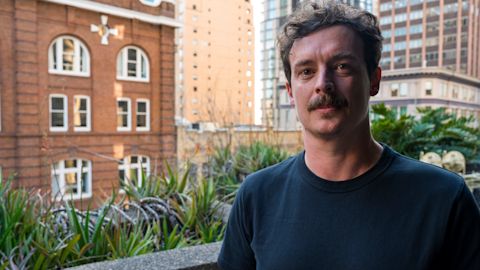Our dedicated homelessness service has been running for more than 30 years. The team works tirelessly to address the complex issue of homelessness and its impact in our city.
For Homelessness Week 2023, we spoke to the manager of our homelessness unit Jon Swain and our senior homelessness project coordinator Katie Phillips about the highs and lows of the work they do.
This is a 7 days a week, 52 weeks a year job
Jon: We’re a small team, with 7 people covering a broad range of work. We regularly coordinate with the mobile voluntary services (charities) that run in the city providing food, showers and other services, and work with our partners to direct them to areas of need. We partner with services that support young people and Aboriginal and Torres Strait Islander People, and we run the Woolloomooloo Integrated Services Hub, a program that coordinates support to help people out of homelessness.
We manage equal access to public space, provide people with support to access housing services alongside our partners, coordinate when there’s extreme weather events, and of course do a lot of advocacy work and the street count every year.
Katie: There’s a distinct difference in the type of work we do. There’s the strategic side, working towards reducing or eradicating homelessness altogether. And then there’s the work on the ground – managing the complexities of people sleeping rough in a public space, for example.
Jon: We have 4 public space liaison officers who manage a lot of the homelessness hotspots. Homelessness isn’t illegal, which is something people may not know. Everyone has a right to use public space, so it’s not as straightforward as simply moving someone on – we don’t have the power to do this anyway, only the Police do.
Where it becomes a problem is if a person has accrued lots of belongings or using a tent or structure which takes up space.
Our public space liaison officers know pretty much everyone on the streets. They’ve built those relationships, that trust. Every day they’ll go to hotspots and work with people to reduce or manage their belongings.
Katie: We also educate businesses. Once we’ve dealt with a complaint about a homeless person who may be sleeping in or around a building or shopping complex, we offer the business or security managers some training about how to deal with any situations going forward and help them understand the perspective of the person sleeping rough.
Our work with partners is fundamental
Jon: Two of our most important partnerships are with the Department of Communities and Justice (the State Government Department responsible for homelessness) and St Vincent’s Health – we do a lot of dedicated health and housing outreach with them. There are about 18 local services that we also work with, plus our advocacy partnerships.
Katie: We also work with other landowners like Property and Development NSW, and the Land and Housing Corporation. We often get called on for our expertise by a range of stakeholders including other local governments.
Jon: Internally, we work very closely with the cleansing and waste team. In fact, I would say emphatically that we wouldn’t be able to do our job without them. Often, we’ll need an intense clean to take place - pressure cleaning or removing discarded belongings. They’ll also let us know if they come across areas where there’s people sleeping rough.
Katie: That’s how the public space liaison officers' jobs started. Our first public space liaison officer was a cleansing and waste worker. He would take the time during his cleansing patrol to talk to people sleeping rough, to get to know them. That was about 18 years ago, and from there we knew this needed to be a dedicated role. You really do need both skillsets - you need the social justice element, but also the very practical ability to deal with waste.
Our organisation was the first local government in Australia to have a dedicated homelessness unit, and now other councils come to us for advice on how to work with people experiencing homelessness.
Jon: Every Wednesday our public space liaison officers go out with St Vincent’s Health team so we can help assess people who we already know have drug and alcohol dependencies or mental health issues, but also to keep track of anyone new we haven’t come across before.
There are a lot of tough times, but we’ve learned to celebrate the wins
Jon: Quite honestly, the work is relentless. There is no downtime. It’s hard sometimes to get through to businesses and the public that homelessness is not the fault of the homeless person. As a society, we’ve allowed this to happen – we’ve watched the erosion of pathways to help these people.
Katie: For us, the work never ends. None of our projects have an end date. So, we really celebrate when someone who’s been on the street for a long time finally gets housed. It’s a very long process, and we often know them over many years, and it means a lot to us personally. On the flip side, seeing someone come out of housing is hard. It could literally be the same names 10 years down the track. You know the system has let them down.
Jon: Most of the people in this sector have been working in it for a long time. You must have passion to have stamina. The support we provide each other really helps us get through those tougher times.
Katie: There are positive elements to the cycle too. All the homeless advisors that do the street count with us have slept rough in the past and are now housed. We’ve been there for that journey, seeing them go from sleeping on the streets, to being placed in accommodation, to wanting to give back to the community themselves.
They get paid for their time but many of them go the extra mile too, like they’ll do food handling courses so they can cook a barbecue for us. It’s amazing that our unit meant enough to them that they want to come back to help.
Jon: I have to mention the advocacy work. When you’re building momentum and the key issues gets traction, it feels huge. Right now, we’re doing work around people on the streets who don’t have residency status and so don’t have access to housing pathways. There are at least 60 or 70 people sleeping rough in our city in this situation, so making sure we’re advocating on their behalf is essential - it’s an issue being taken to federal government as we speak.
Housing-first model changed everything
Katie: Our organisation has been instrumental in championing a housing-first model. The sector used to believe that people needed to be ready for housing – that they needed to be clean from substances, to have done work on their mental health and so on.
We pushed to change that thought process, because we believed having a secure place to live was the number one factor that would lead to other changes in their lives. It was a huge win and led to reforms like Common Ground in Camperdown - housing that includes wrap around services to support people to maintain their tenancies.
Jon: The idea behind Common Ground is housing provided to people sleeping rough should be permanent, not transitional. Going directly from homelessness to permanent housing is the thing that achieves stability, and from there, support to keep them housed. That might be for medical and mental illnesses or substance use. But the goal is to see them stay in their affordable accommodation independently and permanently. It’s been a great success.
Katie: The Platform 70 program was a very specific version of the housing-first model that happened in Woolloomooloo. It’s a small area, only about 1km in total, but there used to be over 90 people sleeping rough there. By providing housing to them, we’ve reduced that number to about 18, and at times this has been even fewer.
Experience and knowledge drives real change
Jon: The maturity of our homelessness unit compared to others around Australia has allowed us to pilot a lot of things now standard in other cities. We’re seen as the leading voice on many homelessness issues.
Katie: We can share our knowledge and learnings with councils in other cities and encourage them to try new things.
Jon: The street count, as a model, is something we should be very proud of. It’s the most consistent data we have, and it’s used to inform our advocacy work. It’s reliable because our methodology has stayed the same since 2008. We can see the patterns and trends.
As I spoke about before, non-residents return to the streets and have complex mental health issues but are not able to be supported because they aren’t eligible for any services. We need to turn our attention to fixing these systems.
Katie: That would mean a federal policy change, but we’re having some success in this area recently. We've done a lot of advocacy work to change the policy applying to New Zealand citizens not eligible for social housing because no reciprocal agreement existed.
Jon: We also need to be looking at the way climate issues are impacting homelessness. Extreme heat and extreme cold will be a growing problem, and we are starting to plan for that now. We’re at a tipping point. If we don’t come together and start trying to solve some of these issues, we’re going to be in a lot of trouble.
Katie: Thankfully, we have an incredibly supportive organisation behind us. I feel lucky to be working in a council that wants to find a way forward.
Published 11 August 2023, updated 28 February 2024



